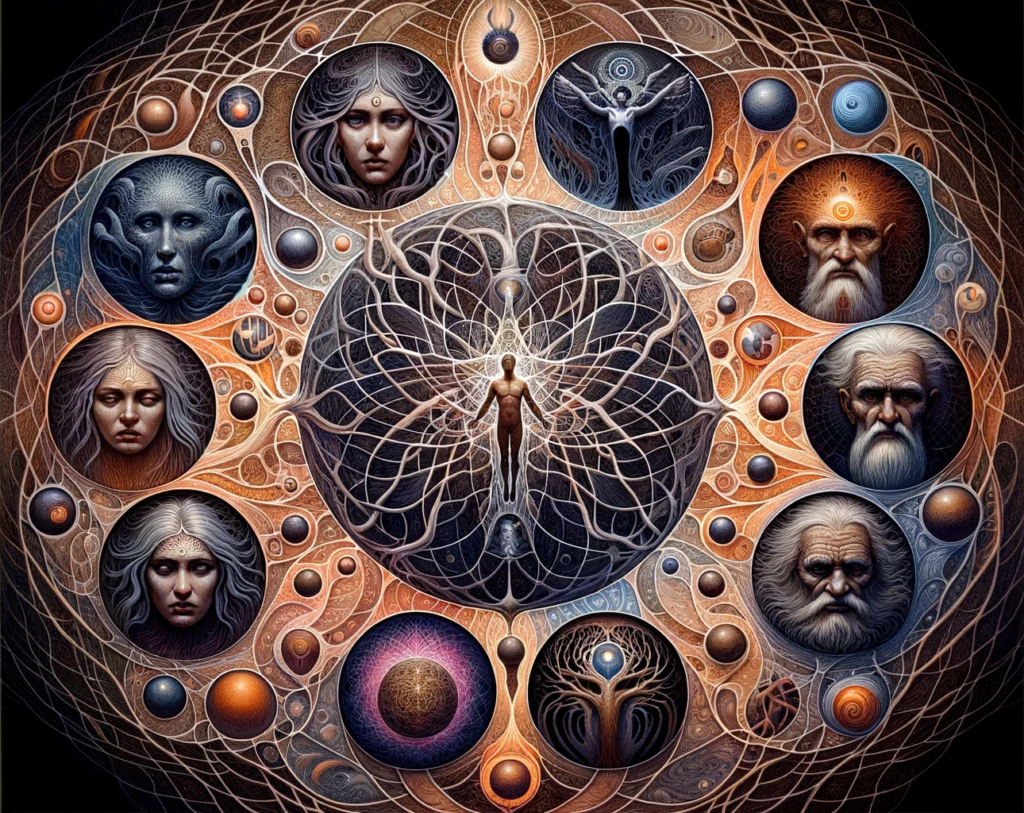Collective Unconscious and Archetypes

The concept of the collective unconscious and archetypes, introduced by psychiatrist Carl Jung, represents an integral part of Jungian psychology. These concepts refer to universal patterns, symbols, and thought forms inherited from our ancestors and shared across all human cultures. The collective unconscious consists of pre-existent forms or archetypes, surfacing in our consciousness through dreams, visions, feelings, art, religion, or symbolic experiences. These archetypes express the instincts and spiritual side of human nature.
According to Jung, the collective unconscious is a unique component of our psyche, serving as a form of psychological inheritance. It contains not only instincts but also archetypes like The Great Mother, the Wise Old Man, the Shadow, and the Tree of Life, which are ancient primal symbols common to human experiences.
Jung’s theories were initially influenced by Sigmund Freud but later diverged significantly. Jung believed that Freud overemphasized sexual desire and repression. In contrast, Jung proposed a multi-layered mind structure, with the collective unconscious representing a universal storehouse of images common to all humanity. This collective unconscious can be accessed through various archetypes, which are like universal containers filled with personal symbols molded by individual cultures or societies.
Experts like Carl Jung have elaborated on various archetypes such as the Self, shadow, anima/animus, and the mandala. The Self represents wholeness or individuation, and the mandala, a circle containing four harmonious parts, symbolizes the unified Self. The shadow represents the dark side of the Self, and the anima (in men) and animus (in women) represent the feminine and masculine counterparts of the personality. Jung believed that achieving harmony within the Self was essential, a process symbolized in various cultural myths and religious symbols.
Carl Jung identified numerous archetypes within the collective unconscious. These archetypes are symbolic, universal patterns that recur in myths, stories, dreams, and cultures. Here’s a list of some well-known archetypes, along with brief descriptions of each:
- The Hero: Embodies courage and strength, often on a quest or journey, facing challenges and overcoming obstacles to achieve a significant goal.
- The Mother: Symbolizes nurturing, caring, and fertility. Often associated with creation, birth, and guidance.
- The Father: Represents authority, protection, and guidance. Often a figure of power and control.
- The Child: Embodies innocence, rebirth, and salvation. Represents the future and new beginnings.
- The Wise Old Man: A symbol of wisdom, knowledge, and guidance. Offers insight and advice to the hero.
- The Trickster: Known for being a deceiver, trickster archetypes challenge the status quo, using cunning and wit.
- The Maiden: Symbolizes purity, desire, and beauty. Often represents romantic interest or the quest for union.
- The Shadow: Represents the hidden or repressed parts of oneself, often the darker side of one’s personality.
- The Anima/Animus: According to Jung, the anima represents the feminine aspects in a man’s psyche, while the animus represents the masculine aspects in a woman’s psyche.
- The Self: Symbolizes the unified unconscious and conscious of an individual, representing the pursuit of self-realization.
- The Magician: Embodies transformation, creation, and the use of personal power.
- The Sage: A figure of wisdom and knowledge, often seeking truth and enlightenment.
- The Outlaw/Rebel: Challenges authority and fights against the status quo, often breaking rules and conventions.
- The Explorer: Represents the pursuit of new experiences, freedom, and adventure.
- The Creator/Artist: Symbolizes creativity, imagination, and the creation of new ideas or things.
- The Ruler: Embodies power, responsibility, and control, often concerned with order and stability.
- The Caregiver: Represents altruism, compassion, and generosity, often selflessly helping others.
- The Innocent: Embodies optimism, goodness, and faith, often seeking happiness and avoiding conflict.
- The Jester: Represents humor, light-heartedness, and the ability to laugh at oneself.
- The Lover: Symbolizes passion, desire, and sensuality, seeking intimacy and experience.
Carl Jung’s theory of the collective unconscious and archetypes offers a profound insight into the shared human experience, transcending individual and cultural differences. It highlights the deep-rooted, instinctual patterns that shape our thoughts, behaviors, and cultural expressions, emphasizing the interconnectedness and universality of human psychology.

